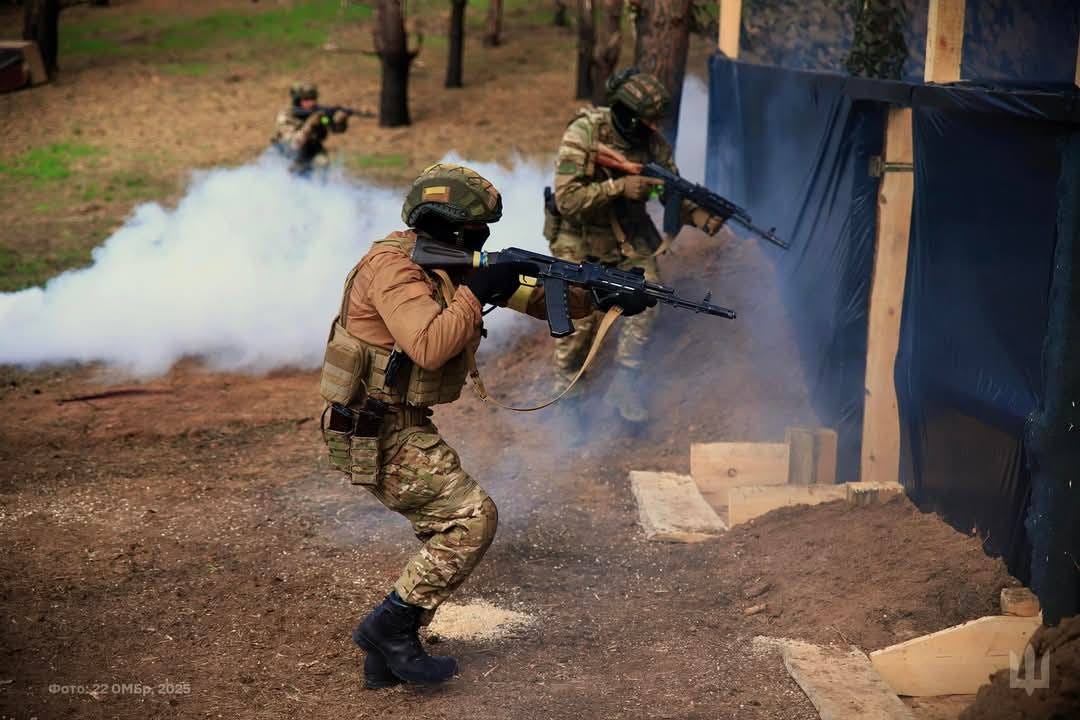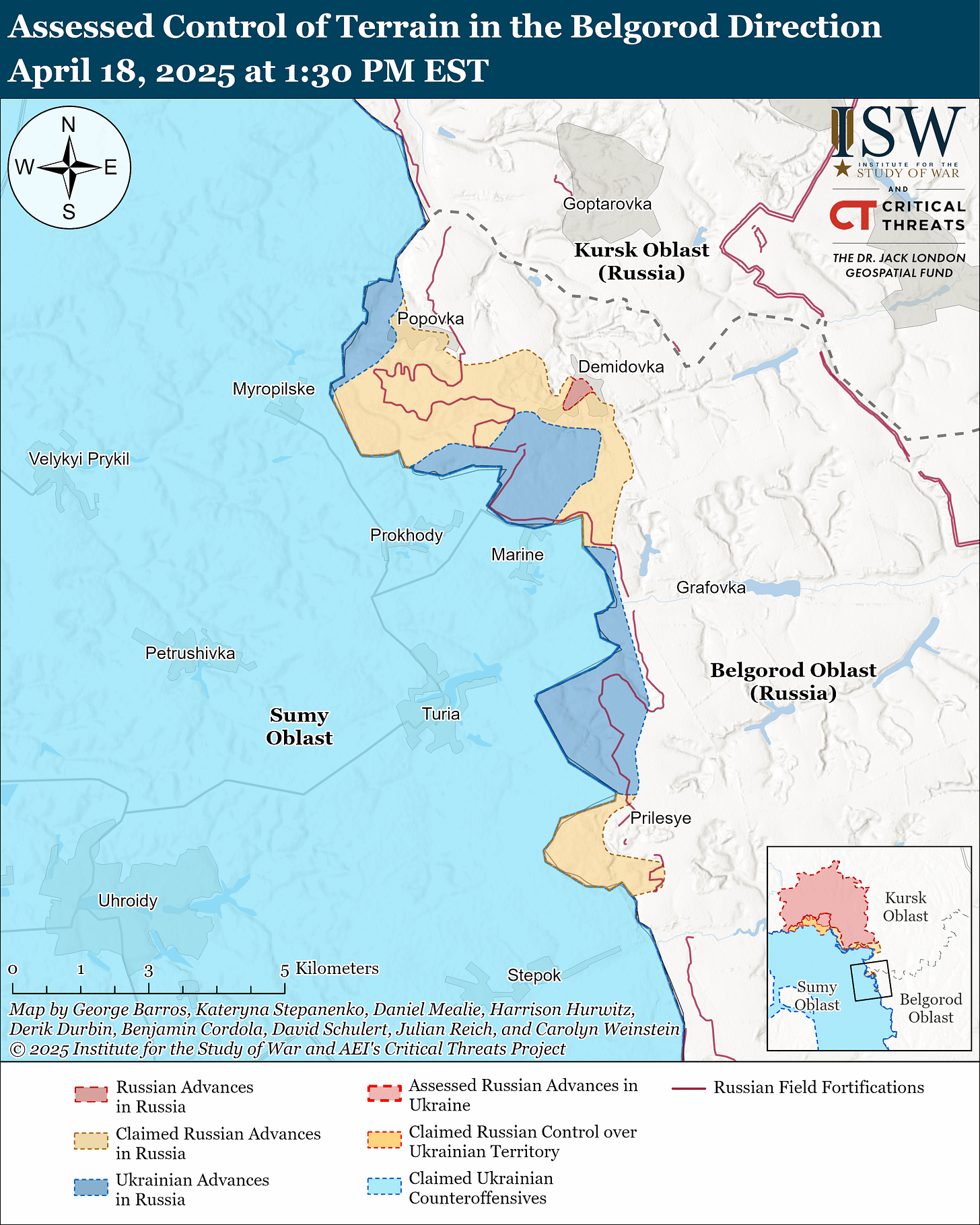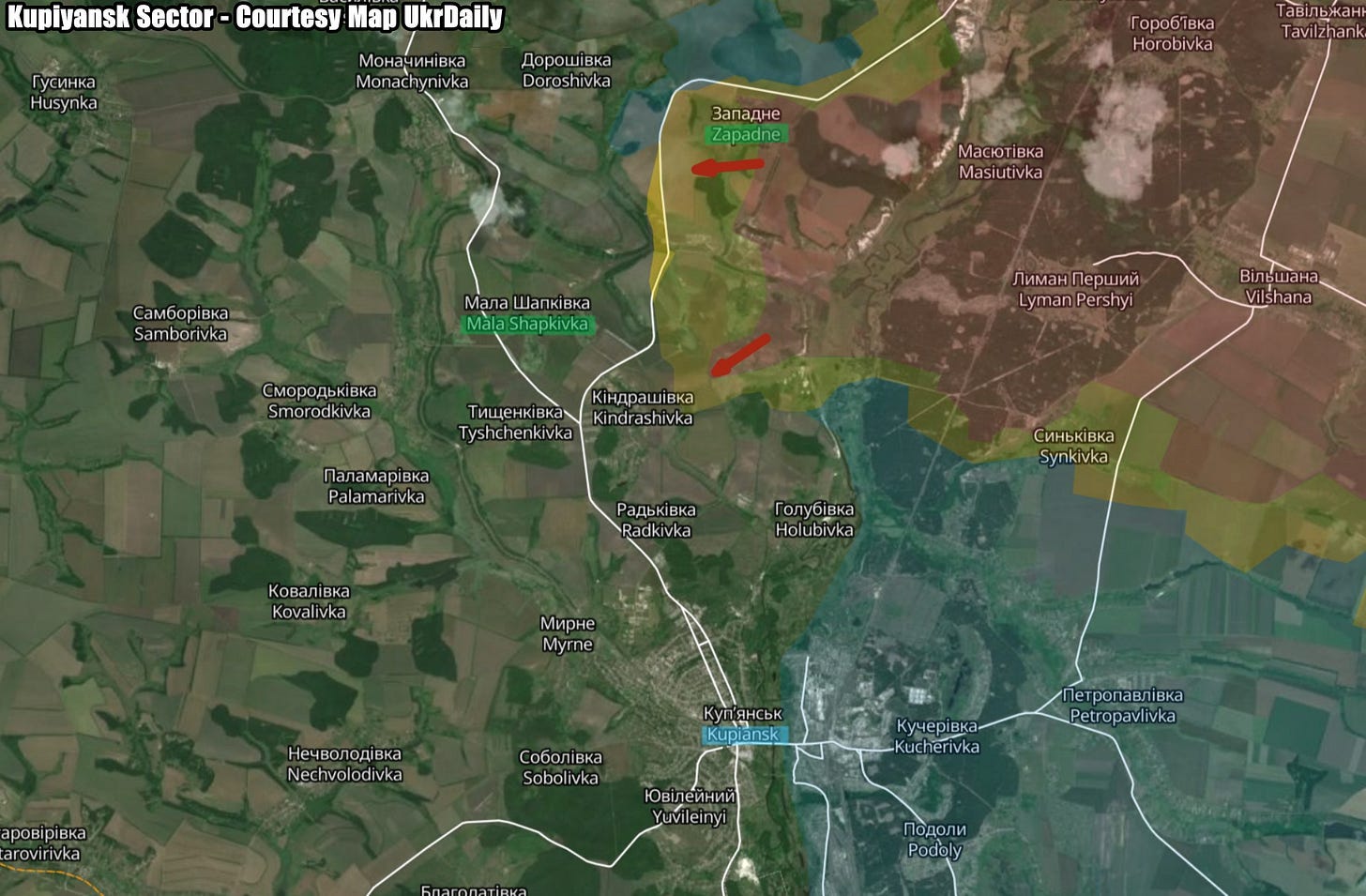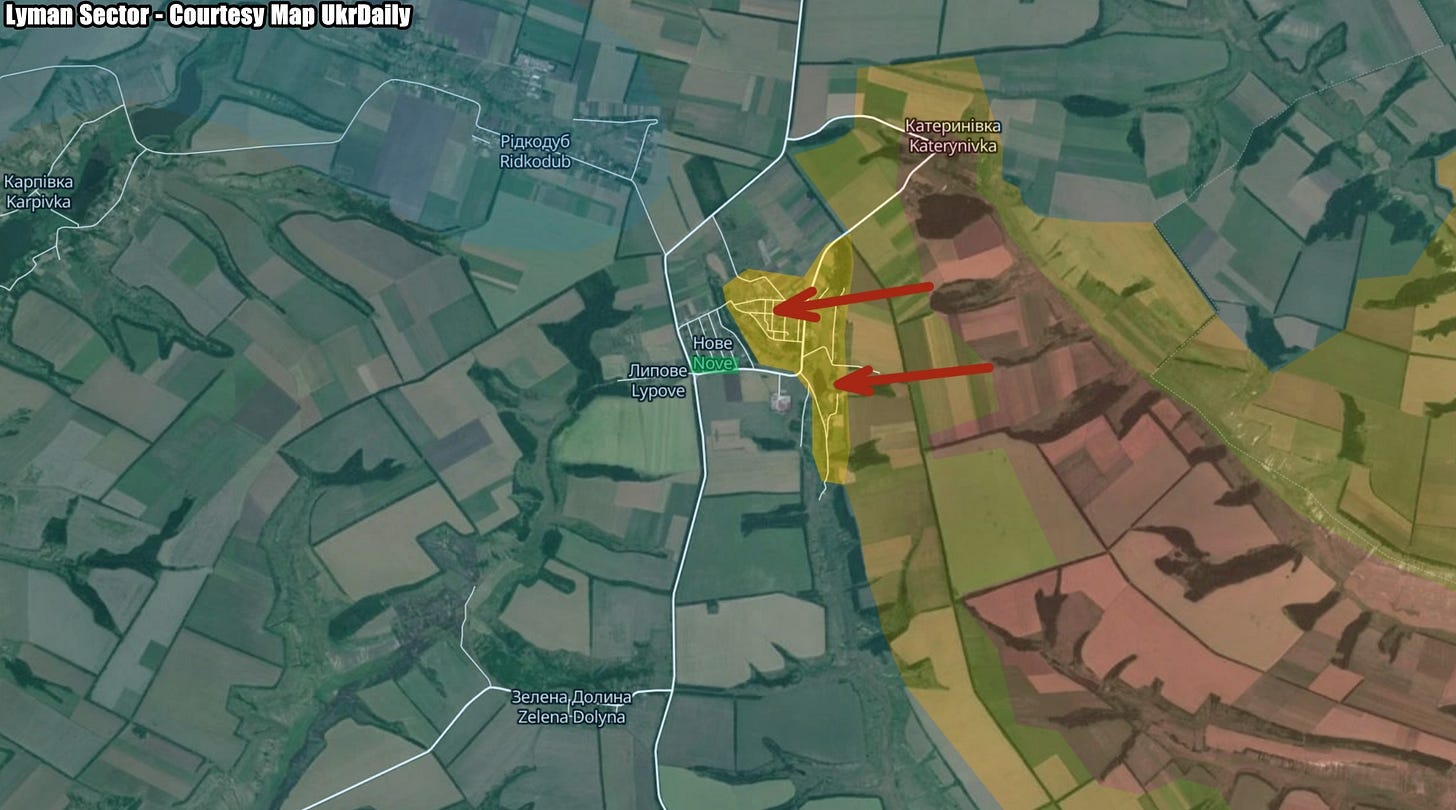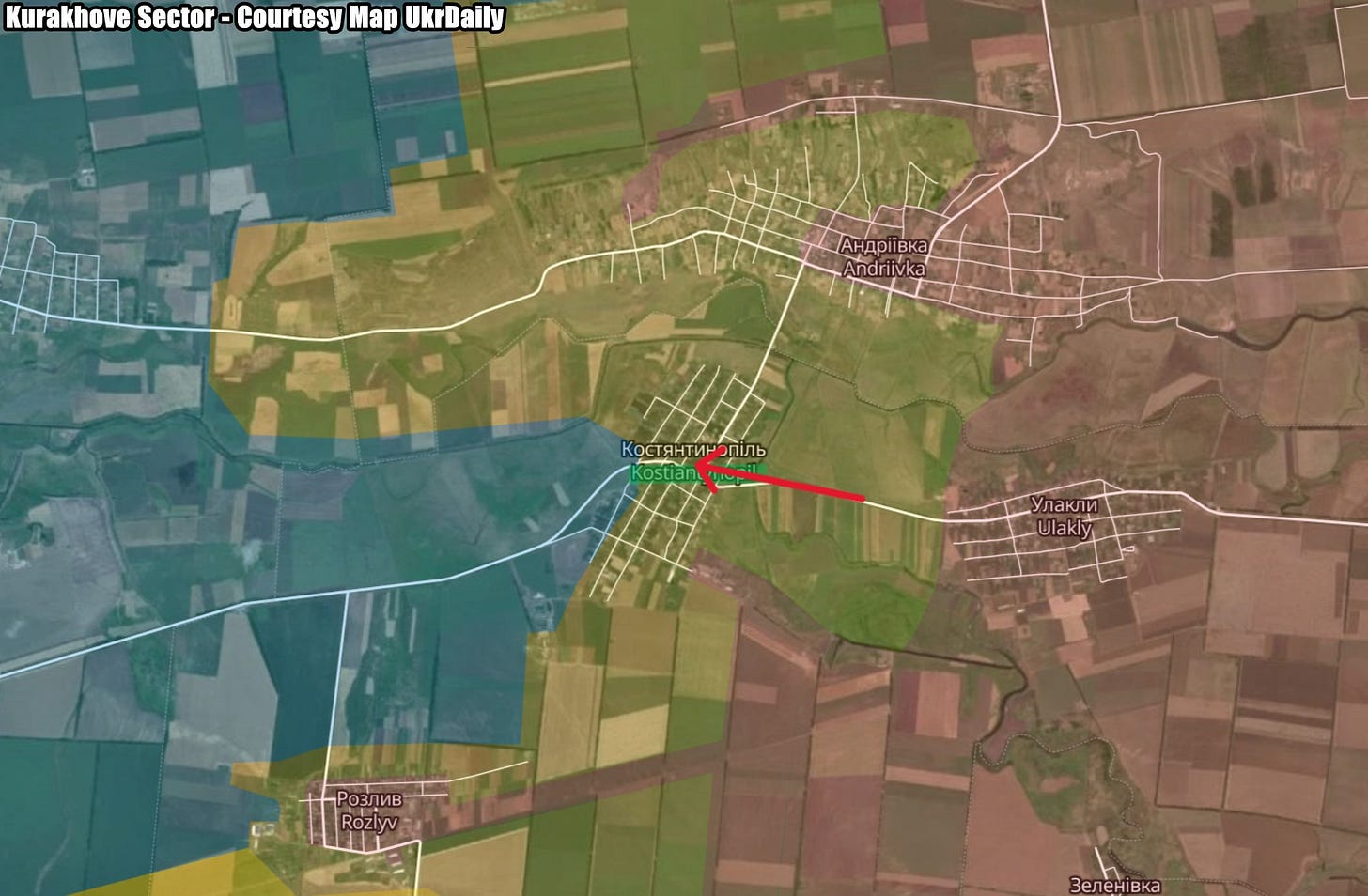Slava Ukraini! In early 2022 I began a Telegram channel aggregating news from a number of sources daily on the war in Ukraine. In June 2023 I began providing a daily draft for the Ukraine War Brief Podcast collecting news from over 70 sources daily, which formed the basis of the script. While the Podcast no longer exists I have continued to make this Brief available for my followers here on Substack for those who wish to keep up with the news from the war.
All the latest news on the Russo-Ukraine War 6 days per week
ALONG THE CONTACT LINE
GSAFU Morning Report
For: April 19, 2025
The General Staff of the Armed Forces of Ukraine in its Operational Information update at 08:00 on Apr 19 stated that day 1151 of the full-scale invasion of the Russian Federation against Ukraine had begun.
The situation on the line of combat remains tense in some sectors. Ukrainian defenders continue to actively counteract the Russian aggressor, causing them significant losses in personnel, equipment and technology. Exhausting the enemy along the entire front line and continuing to disrupt the plans of Russian occupiers to advance deeper into the territory of Ukraine.
During the past day, 162 combat engagements took place.
Over the past 24 hours, the enemy carried out 5 missile strikes, 103 air strikes, used 2,885 drones and fired approximately 6,200 artillery shells across the positions of Ukrainian forces and civilians.
Air Force Daily Report
33 ENEMY UAVS SHOT DOWN, 36 SIMULATOR UAVS FAILED TO REACH THEIR TARGETS (LOCATIONALLY LOST)
➖➖➖➖➖➖➖➖➖
On the night of April 19, 2025 (9:00 p.m. April 18), the Russian occupiers launched a strike on Ukraine with ground-based and air-based missiles and strike UAVs.
According to preliminary data, the Air Force radio-technical troops detected and escorted 95 enemy air attack vehicles — 8 missiles of various types and 87 strike UAVs (simulator drones of other types), including:
- 3 Iskander-M ballistic missiles (launch area – Crimea);
- 2 Onyx anti-ship missiles (launch area – Crimea);
- 3 Kh-31P anti-radar missiles;
- 87 Shahed attack UAVs and other types of simulator drones (launch areas – Millerovo, Kursk, Primorsko-Akhtarsk – Russian Federation, Gvardiyskoe – Crimea).
The enemy air attack was repelled by aviation, anti-aircraft missile units, electronic warfare equipment, and mobile fire groups of the Defense Forces of Ukraine.
As of 09:00, it has been confirmed that 33 Shahed attack UAVs (and other types of drones) have been shot down in the east, north, and south of the country.
36 enemy drones-simulators - lost in location (without negative consequences).
As a result of the enemy attack, the Odessa, Kharkiv, Sumy, Donetsk, and Zaporizhia regions suffered.
Combat Operations in the Russian Federation
The Institute for the Study of War (ISW), a US based think tank, in its Apr 18 Russian Offensive Campaign Assessment reported that:
Kursk Salient: Russian forces recently advanced in Kursk Oblast.
Geolocated footage published on Apr 17 indicates that Russian forces recently advanced on the northern outskirts of Gornal (southwest of Sudzha).
Belgorod Incursion: Fighting continued in the northwesternmost Belgorod Oblast on Apr 18, but Russian forces did not advance.
The Khortytsia operational-strategic group
(Responsible for the northeastern part of Ukraine. )
Kupyansk Sector: Russian forces recently advanced in the Kupyansk direction.
Geolocated footage published on Apr 17 and 18 indicates that Russian forces recently advanced near the P-79 Kupyansk-Dvorichna highway southwest of Zapadne (north of Kupyansk) and to the eastern outskirts of Mala Shapkivka (northwest of Kupyansk), respectively.
Lyman Sector: Russian forces recently advanced in the Lyman direction.
Assessed Russian advances: Geolocated footage published on Apr 17 indicates that Russian forces recently advanced within central Nove (northeast of Lyman).
Toretsk Sector: Ukrainian forces recently advanced in the Toretsk direction.
Geolocated footage published on April 18 indicates that Ukrainian forces recently advanced northwest of Druzhba (northeast of Toretsk).
The Tavria operational-strategic group
(Responsible for the central-eastern and southeastern part of Ukraine.)
Kurakhove Sector: Russian forces recently advanced in the Kurakhove direction.
Geolocated footage published on Apr 18 indicates that Russian forces recently advanced in central Kostyantynopil (west of Kurakhove).
The Odesa operational-strategic group
(Responsible for Kherson, Qırım, (also known as Crimea) and the Black Sea.)
There have been no major changes to the combat environment since our last report.
TEMPORARILY OCCUPIED TERRITORIES
Nothing major to report.
THE HOME FRONT
Russian drone hits bakery preparing Easter cakes, killing one.
A Russian drone strike early on Friday hit a bakery in northern Ukraine where traditional Easter cakes were being prepared, killing one man, Reuters reported citing Ukrainian officials.
Images shared by Ukrainian emergency services, which said they were filmed at the scene of the strike in the city of Sumy, showed trays of Easter cakes - known as paska in Ukrainian - covered in grey dust, and a smashed window nearby.
The victim was a local businessman who was at the bakery to collect his order when the drone struck at 5 a.m. (0200 GMT), according to Ukrainian Foreign Minister Andrii Sybiha.
Ukraine's Christian community, including Orthodox believers, Catholics and Protestants, were marking the Good Friday religious holiday on Friday, and preparing to celebrate Easter on Sunday.
"So much for Russia's 'traditional Christian values.' It is against the Lord, any faith, and any human values to strike an ordinary pastry shop, murder an entrepreneur, and destroy Easter bread. This is the evil we are dealing with every day," Sybiha wrote on Twitter.
Last Sunday, two Russian ballistic missiles hit the centre of Sumy, killing 35 people in the deadliest strike on Ukraine this year, Ukrainian officials said.
Russian attacks cause blackouts in Sumy Oblast after Moscow says energy truce over.
Blackouts have been reported in Sumy oblast after Russian strikes near Konotop and surrounding settlements on April 18, the Kyiv Independent reports.
The attacks come shortly after Moscow announced an end to the partial ceasefire on energy infrastructure strikes in effect between Russia and Ukraine. Kremlin spokesperson Dmitry Peskov said earlier on April 18 that the one-month period for the energy truce had expired.
According to Suspilne, explosions were heard near the city of Konotop around 8:00 p.m. local time.
While Konotop Mayor Artem Semenikhin reported that were no casualties or injuries, settlements in Sumy Oblast, including Krolevets and Shostka, lost power after the strikes. Local residents also reported that the water supply had been shut off.
Local energy officials confirmed on Telegram that the blackouts were a result of Russian strikes on energy infrastructure.
In March, the United States brokered a partial ceasefire between Russia and Ukraine on attacks against energy facilities, after the Kremlin refused to accept a full 30-day ceasefire on all hostilities.
Since then, Moscow has violated the ceasefire more than 30 times, Foreign Ministry Spokesperson Heorhii Tykhyi said on April 16.
In his comments on April 18, Peskov did not go into detail as to whether Russia plans to resume attacks on energy facilities or extend the ban. The attacks against Sumy Oblast indicate that Russia will not extend the partial ceasefire and has resumed attacks on critical infrastructure.
Kyiv has already agreed to enter an immediate ceasefire on all attacks once Moscow accepts the same terms. Russia continues to refuse, delaying and obstructing attempts to negotiate a comprehensive peace agreement.
U.S. President Donald Trump said on April 18 that Washington may "take a pass" on peace negotiations if either side makes it too difficult to secure a deal.
RUSSIAN WORLD
St. Petersburg Court Jails Anti-War Teenager Nearly 3 Years for ‘Discrediting’ Army.
A judge in St. Petersburg sentenced 19-year-old anti-war activist Daria Kozyreva to nearly three years in prison on Friday for repeatedly “discrediting” the Russian military, the Moscow Times reported.
Petrogradsky District Court Judge Dmitry Ovrakh ordered Kozyreva to serve two years and eight months at a medium-security penal colony and banned her from publishing anything on the internet for two and a half years. Prosecutors sought a six-year prison sentence.
Kozyreva was arrested in February 2024 after she attached a poem by Ukrainian writer Taras Shevchenko to his monument in St. Petersburg.
Law enforcement authorities brought a second charge against Kozyreva in August, citing her in interview with Radio Free Europe/Radio Liberty (RFE/RL) following her expulsion from St. Petersburg State University. Kozyreva denied the charges in court on Friday.
“My opinion is that the army discredited itself after the full-scale invasion, so any statement against it will discredit nothing,” she was quoted as saying by the exiled news outlet Mediazona.
In her final statement in court, Kozyreva condemned the February 2022 invasion and applauded Ukrainians for “defending their homeland.”
“Ukraine is a free country, a free nation, and it will decide its own destiny,” she said. “It is clear that Putin cannot get his head around the idea that Ukraine is a sovereign nation.”
Kozyreva was released from pre-trial detention in February under restrictions barring her from leaving home at night, using the internet or speaking to the press until Dec. 2. In 2023, she was fined 30,000 rubles ($365) for an anti-war social media post and expelled from university.
The year before, Kozyreva was arrested for writing “Murderers, you bombed it to rubble. Judases” on a public installation symbolizing the “brotherhood” between St. Petersburg and Mariupol — an occupied Ukrainian city that was largely destroyed in a Russian siege.
RELATED INTERNATIONAL NEWS
Ukraine sanctions three Chinese companies for Russian missile production role.
Kyiv levied sanctions against 99 foreign targets, including Chinese firms tied to Iskander missile production, which Beijing denies, RFE/RL reports.
On Apr 18, Ukraine imposed sanctions on three Chinese companies, claiming they were involved in the production of advanced Iskander missiles that Russia uses in its war against Ukraine. This action came a day after President Volodymyr Zelenskyy alleged that China had been supplying weapons to Russia.
According to the updated sanctions list published by Zelenskyy’s Office on Apr 18, the targeted Chinese entities include Beijing Aviation And Aerospace Xianghui Technology Co. Ltd, Rui Jin Machinery Co. Ltd, and Zhongfu Shenying Carbon Fiber Xining Co. Ltd.
“Today, we have expanded our Ukrainian sanctions against nearly a hundred more entities—natural and legal persons—most of whom are involved in the production of such missiles—Iskanders—like those that struck our Kharkiv. Many of these entities are Russian, but unfortunately, some are also from China,” Zelenskyy said in a statement on Twitter.
On that day that Russia struck the northeastern Ukrainian city of Kharkiv with Iskander missiles, killing one person and injuring 113, including nine children. Zelenskyy reported that one of the missiles detonated in midair over a residential neighborhood, while another struck an industrial site nearby.
The sanctions, which ban companies from doing business in Ukraine and freeze their assets there, were implemented following a decision by Ukraine’s National Security and Defense Council. The list includes 39 Russian citizens and 56 Russian companies, as well as one Belarusian enterprise SvitlohirskKhimVolokno.
On Apr 17, Zelenskyy told reporters that Ukraine had evidence of China supplying military goods to Russia, including gunpowder and artillery, and said more details could emerge the following week—possibly showing Chinese involvement in weapons production inside Russia.
During a press conference on Apr 18, Zelenskyy claimed his government had evidence that Chinese firms were supplying artillery and gunpowder to Russia and that Chinese entities were involved in weapons production on Russian soil, though he provided no supporting evidence.
Russia’s effort to get US to drop aviation sanctions hits EU resistance.
Moscow is lobbying for the U.S. to open its skies to Russian airlines as part of a ceasefire deal with Ukraine, Politico reports.
But there's a big problem with that scheme — the EU isn't keen, and without Europe on board it won't be easy for Russian carriers to fly to the United States.
“First, EU sanctions stand firm against Russia, which includes a ban on Russian airlines flying over EU airspace,” said a European Commission official speaking on condition of anonymity.
Beyond the political decisions on sanctions, the EU official also pointed to “major safety and security issues” related to the possible reopening of EU airspace to Russian jets, as “it is not known if Russian air operators and air traffic services have been properly maintained over the past three years, putting the airworthiness of the Russian fleet seriously in question.”
Since Moscow's February 2022 invasion of Ukraine, Russian airlines have been banned from landing in and flying over the territory of the EU and the U.S., as well as from accessing spare parts for aircraft from Western manufacturers such as Boeing or Airbus. The Kremlin retaliated by blocking Western airlines from its airspace.
“As a result, there’s a high probability that bogus parts are being installed in aircraft operating within the Russian domestic market,” said Sander Starreveld, director of the SIG Aviation consultancy, warning of risks to aviation safety. “Allowing these aircraft to operate commercially in Europe is not only unsafe but also risks introducing counterfeit parts into the Union.”
In practical terms, reopening Europe's skies to Russian airlines such as flag carrier Aeroflot would also place a massive burden on the EU Aviation Safety Agency (EASA).
The agency would be required to ensure that Russian airplanes have a level of safety that is equivalent with aircraft already operating in the EU, Starreveld said. “This process takes time, especially considering the workload involved.”
In addition to safety and certification issues, many Russian planes may never be able to land in Europe again because they are actually not Russian but were stolen from plane lessors after the invasion.
“Some aircraft could be seized immediately upon landing in Europe due to Russia’s unilateral decision to nationalize leased aircraft,” Starreveld said, noting that “there are massive debts owed to Western leasing companies, and I expect they’ll try to recover as many assets as possible.”
Despite such problems, Russia is demanding the resumption of direct flights to the U.S. as part of any agreement to stop fighting. Such a step “should be a consequence of the lifting of sanctions on Aeroflot,” Russian Foreign Minister Sergey Lavrov said on April 11.
“The Americans considered it, [but] so far we have not seen any reciprocal step,” the Russian minister said.
On Wednesday, Russia reportedly asked Washington to be allowed to buy planes built by U.S. manufacturer Boeing and to pay for them with Russian state assets that have been frozen since the start of the war, provided a ceasefire is reached.
So far the Trump administration has not lifted any sanctions on Russia, but some signals are giving the Kremlin hope.
In March, the head of the American Chamber of Commerce in Russia, Robert Agee, publicly called for the lifting of sanctions in the aviation sector.
“Russia has a huge fleet of Western planes, mostly Boeing. We believe we should provide spare parts and technical support for them, so we will try to have these sanctions lifted,” Agee told the Russian business daily RBC, adding: “This is less a business wish and more of a humanitarian necessity, as ordinary citizens suffer primarily from this."
Any effort to loosen restrictions on U.S. and Russian airlines would increase pressure for similar steps from European carriers. The latter have long complained about the extra cost of avoiding Russia's vast airspace when flying to Asia, which has given an advantage to Chinese airlines.
Despite these competitive concerns, Brussels is wary of entering into negotiations with Moscow over access to its airspace, in part because of the unsafe nature of Russian skies.
The Commission official called the security of Russian airspace “problematic,” citing the Christmas Day crash of an Azerbaijan Airlines flight — allegedly after being struck by a Russian air defense missile — that prompted EASA to advise airlines to avoid all of western Russia.
Russian President Vladimir Putin apologized for the crash but stopped short of saying Russia had been responsible.
MILITARY & TECH
NATO Urges Germany to Nearly Double Army Size.
NATO’s updated defense plans call for Germany to expand its armed forces to 395,000 personnel—an increase of more than 80% from current levels, Militarnyi reports.
According to the latest official data from the German Ministry of Defense dated February 28, 2025, the Bundeswehr currently has 182,667 soldiers.
The demand, reported by the CPM Defense Network, comes ahead of the NATO summit scheduled for June 24–26 in The Hague, where the Alliance is expected to adopt new measures to counter continued Russian aggression.
The plans envision a significantly expanded German force as part of a broader effort to build a stronger European military posture.
However, the publication notes that implementation is likely to face delays, particularly when it comes to reaching agreement on force levels.
Under the revised framework, Germany would be required to field a force of at least 395,000 troops—far more than the current 183,000 active soldiers and 60,000 reservists.
German officials and military experts have expressed skepticism, citing both financial and recruitment challenges. Still, the proposed number remains well below Cold War levels.
In a recent interview, retired General Eberhard Zorn, former Inspector General of the Bundeswehr, said the proposed expansion would require five to seven additional brigades, organized into two new divisions on top of the three currently in operation. He also called for replenishing existing units.
“From a materiel standpoint, this is achievable if industry aligns with defense planning. The real challenge is personnel—especially since the military is labor-intensive,” Zorn said. “That’s why many are calling for the return of conscription. Personally, I’d even consider universal service for men and women, with flexible formats. But organizing and equipping that will take considerable time.”
Germany has already begun to bolster its defense infrastructure. In March 2025, Berlin launched its first territorial defense division (Heimatschutzdivision), a 6,000-strong unit tasked with protecting critical infrastructure in peacetime and supporting troop movements or disaster relief.
In wartime, the division would help counter military threats and reinforce deterrence efforts.
That’s it for today’s Brief folks if you would like to keep up with events in Ukraine daily please consider subscribing, it’s free!





